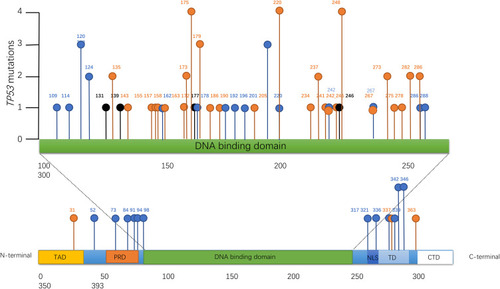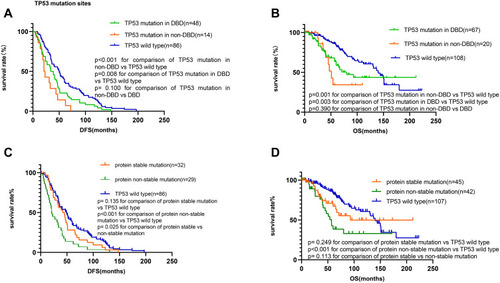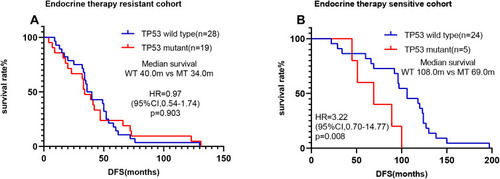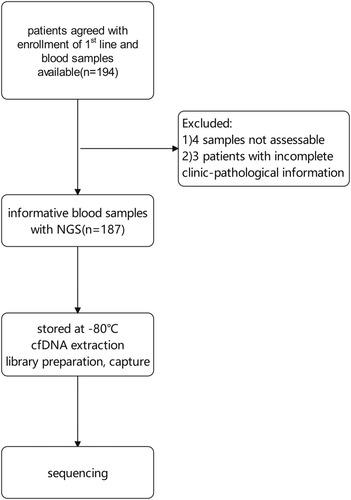Figures & data
Table 1 Baseline Clinical Characteristics of TP53 Wild-Type and -Mutated Metastatic Breast Cancer Patients (n=187)
Figure 2 The mutational spectra of TP53 in TP53-mutated patients. (
 ) Truncating (
) Truncating ( ) Inframe.
) Inframe.
Figure 3 Survival analyses by Kaplan–Meier according to TP53 status in MBC patients. (A and B) TP53 wild-type patients had a significantly better clinical outcome than TP53-mutated patients. (C and D) there were no significant differences between TP53 wild-type and -mutated patients in the HER2-positive cohort. (E and F) TP53 wild-type patients had a significantly longer median DFS and OS than TP53-mutated patients in the HR+/HER2– cohort. (G and H) TP53 wild-type patients had a significantly longer median DFS than TP53-mutated patients in the TNBC cohort.

Figure 4 Survival analyses by Kaplan–Meier according to TP53 mutation sites in MBC patients. (A) Patients with a mutation in the non-DNA binding domain had a significantly shorter median DFS than TP53 wild-type patients and those with mutations in the DNA-binding domain. (B) Patients with a mutation in the non-DNA binding domain had shorter median OS than TP53 wild-type patients and those with mutations in the DNA-binding domain. (C) Patients with protein non-stable mutation had shortest median DFS than patients with protein stable mutation and TP53 wild-type patients. (D) Patients with protein non-stable mutation had shortest median OS than patients with protein stable mutation and TP53 wild-type patients.

Figure 5 Survival analyses by Kaplan–Meier according to TP53 mutation type in the DNA binding domain. (A and B) Patients with non-missense mutations in the DNA binding domain had a significantly shorter median DFS and OS than TP53 wild-type patients and those with missense mutations in the DNA binding domain.

Table 2 Univariate and Multivariate Cox Regression Analysis of DFS in TP53 Wild-Type and -Mutated Patients
Table 3 Clinical Characteristics of Patients Receiving Adjuvant Endocrine Therapy (n=96)
Figure 6 Survival analyses by Kaplan–Meier according to TP53 status in MBC receiving adjuvant endocrine therapy. (A) There was no significant difference in TP53 status in the endocrine therapy-resistant cohort. (B) TP53 wild-type patients had a significantly better clinical outcome than TP53-mutated patients in the endocrine therapy sensitive cohort.


